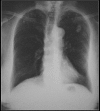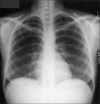The calcified lung nodule: What does it mean?
- PMID: 20582171
- PMCID: PMC2883201
- DOI: 10.4103/1817-1737.62469
The calcified lung nodule: What does it mean?
Abstract
The aim of this review is to present a pictorial essay emphasizing the various patterns of calcification in pulmonary nodules (PN) to aid diagnosis and to discuss the differential diagnosis and the pathogenesis where it is known. The imaging evaluation of PN is based on clinical history, size, distribution and the gross appearance of the nodule as well as feasibility of obtaining a tissue diagnosis. Imaging is instrumental in the management of PN and one should strive not only to identify small malignant tumors with high survival rates but to spare patients with benign PN from undergoing unnecessary surgery. The review emphasizes how to achieve these goals. One of the most reliable imaging features of a benign lesion is a benign pattern of calcification and periodic follow-up with computed tomography showing no growth for 2 years. Calcification in PN is generally considered as a pointer toward a possible benign disease. However, as we show here, calcification in PN as a criterion to determine benign nature is fallacious and can be misleading. The differential considerations of a calcified lesion include calcified granuloma, hamartoma, carcinoid, osteosarcoma, chondrosarcoma and lung metastases or a primary bronchogenic carcinoma among others. We describe and illustrate different patterns of calcification as seen in PN on imaging.
Keywords: Benign pulmonary nodules; calcification; malignant pulmonary nodules.
Conflict of interest statement
Figures






































Similar articles
-
The solitary pulmonary nodule.Radiology. 2006 Apr;239(1):34-49. doi: 10.1148/radiol.2391050343. Radiology. 2006. PMID: 16567482 Review.
-
Management of solitary pulmonary nodules.Dis Mon. 1991 May;37(5):271-318. doi: 10.1016/s0011-5029(05)80012-4. Dis Mon. 1991. PMID: 2019220 Review.
-
CT features of peripheral pulmonary carcinoid tumors.AJR Am J Roentgenol. 2011 Nov;197(5):1073-80. doi: 10.2214/AJR.10.5954. AJR Am J Roentgenol. 2011. PMID: 22021498
-
[Computed tomography of the solitary pulmonary nodule].Nihon Igaku Hoshasen Gakkai Zasshi. 1990 Nov 25;50(11):1321-34. Nihon Igaku Hoshasen Gakkai Zasshi. 1990. PMID: 2087391 Japanese.
-
A visual and semi-quantitative assessment of (99m)Tc-EDDA/HYNIC-TOC scintigraphy in differentiation of solitary pulmonary nodules.Nucl Med Rev Cent East Eur. 2004;7(2):143-50. Nucl Med Rev Cent East Eur. 2004. PMID: 15968601 Clinical Trial.
Cited by
-
Solitary pulmonary nodule: A diagnostic algorithm in the light of current imaging technique.Avicenna J Med. 2011 Oct;1(2):39-51. doi: 10.4103/2231-0770.90915. Avicenna J Med. 2011. PMID: 23210008 Free PMC article.
-
Abnormalities suggestive of latent tuberculosis infection on chest radiography; how specific are they?J Clin Tuberc Other Mycobact Dis. 2019 Jan 25;15:100089. doi: 10.1016/j.jctube.2019.01.004. eCollection 2019 May. J Clin Tuberc Other Mycobact Dis. 2019. PMID: 31720416 Free PMC article.
-
Thoracic calcifications on magnetic resonance imaging: correlations with computed tomography.J Bras Pneumol. 2019 Jul 29;45(4):e20180168. doi: 10.1590/1806-3713/e20180168. J Bras Pneumol. 2019. PMID: 31365682 Free PMC article.
-
Recurrent Pneumonia due to Fibrosing Mediastinitis in a Teenage Girl: A Case Report with Long-Term Follow-Up.Case Rep Pediatr. 2018 Mar 18;2018:3246929. doi: 10.1155/2018/3246929. eCollection 2018. Case Rep Pediatr. 2018. PMID: 29744231 Free PMC article.
-
Pulmonary alveolar microlithiasis with low fluorodeoxyglucose accumulation in PET/computed tomography.Ann Thorac Med. 2011 Oct;6(4):237-40. doi: 10.4103/1817-1737.84781. Ann Thorac Med. 2011. PMID: 21977072 Free PMC article.
References
-
- Grewal RG, Austin JH. CT demonstration of calcification in carcinoma of the lung. J Comput Assist Tomogr. 1994;18:867–71. - PubMed
-
- Caskey CI, Templeton PA, Zerhouni EA. Current evaluation of the solitary pulmonary nodule. Radiol Clin North Am. 1990;28:511–20. - PubMed
-
- Mahoney MC, Shipley RT, Corcoran HL, Dickson BA. CT demonstration of calcification in carcinoma of the lung. AJR Am J Roentgenol. 1990;154:255–8. - PubMed
-
- Siegelman SS, Khouri NF, Scott WW, Jr, Leo FP, Hamper UM, Fishman EK, et al. Pulmonary hamartoma: CT findings. Radiology. 1986;160:313–7. - PubMed
-
- Oldham HN, Jr, Young WG, Jr, Sealy WC. Hamartoma of the lung. J Thorac Cardiovasc Surg. 1967;53:735–42. - PubMed

